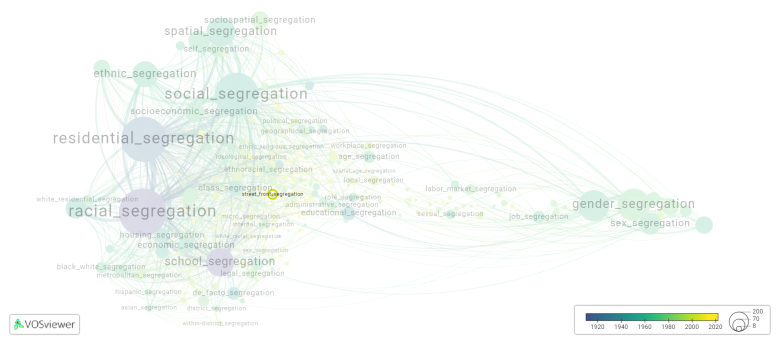Street front segregation: Difference between revisions
(Creating page) |
(Creating page) |
||
| (6 intermediate revisions by the same user not shown) | |||
| Line 1: | Line 1: | ||
===== Date and country of first publication<ref>Date and country of first publication as informed by the Scopus database (December 2023).</ref>===== | |||
2015<br> | 2015<br> | ||
United States | United States | ||
===== Definition ===== | |||
Street front segregation refers to the separation of different socioeconomic or ethnic groups along a street or neighborhood. This can occur due to various factors such as unequal access to resources, discriminatory practices, or historical patterns of segregation. | Street front segregation refers to the separation of different socioeconomic or ethnic groups along a street or neighborhood. This can occur due to various factors such as unequal access to resources, discriminatory practices, or historical patterns of segregation. | ||
| Line 12: | Line 12: | ||
Addressing street front segregation requires comprehensive strategies that promote inclusivity, fair housing policies, and equitable distribution of resources. This can include efforts such as community development initiatives, affordable housing programs, improved urban planning, and policies that promote diversity and integration. | Addressing street front segregation requires comprehensive strategies that promote inclusivity, fair housing policies, and equitable distribution of resources. This can include efforts such as community development initiatives, affordable housing programs, improved urban planning, and policies that promote diversity and integration. | ||
==See also== | ==See also== | ||
==Related segregation forms== | |||
Street front segregation is frequently discussed in the literature with the following segregation forms: | |||
[[racial segregation]], [[residential segregation]] | |||
[[File:street_front_segregation.png|780x780px]] | |||
This visualization is based on the study [[Segregation_Wiki:About| The Multidisciplinary Landscape of Segregation Research]]. | |||
For the complete network of interrelated segregation forms, please refer to: | |||
* [https://tinyurl.com/2235lkhw First year of publication] | |||
* [https://tinyurl.com/2d8wg5n3 Louvain clusters] | |||
* [https://tinyurl.com/223udk5r Betweenness centrality] | |||
* [https://tinyurl.com/244d8unz Disciplines in which segregation forms first emerged (Scopus database).] | |||
==References== | ==References== | ||
==Notes== | ==Notes== | ||
<references /> | <references /> | ||
{{NoteAI}} | {{NoteAI}} | ||
== | ==Street front segregation appears in the following literature== | ||
Grigoryeva A., Ruef M. (2015) The Historical Demography of Racial Segregation. ''American Sociological Review'', ''80''(4), 814-842. American Sociological Association. | Grigoryeva A., Ruef M. (2015). The Historical Demography of Racial Segregation. ''American Sociological Review'', ''80''(4), 814-842. American Sociological Association.https://doi.org/10.1177/0003122415589170 | ||
Latest revision as of 07:17, 16 October 2024
Date and country of first publication[1][edit | edit source]
2015
United States
Definition[edit | edit source]
Street front segregation refers to the separation of different socioeconomic or ethnic groups along a street or neighborhood. This can occur due to various factors such as unequal access to resources, discriminatory practices, or historical patterns of segregation.
Street front segregation can be observed through the physical characteristics and amenities present in a particular area. For example, wealthier neighborhoods often have cleaner streets, well-maintained buildings, and a variety of upscale shops and restaurants. On the other hand, lower-income neighborhoods may have dilapidated buildings, fewer amenities, and a higher concentration of certain types of businesses such as fast-food chains or check-cashing services.
This type of segregation can have significant impacts on individuals and communities. It can result in limited access to quality education, healthcare, and other essential resources for those living in disadvantaged neighborhoods. It can also contribute to social and economic inequalities as well as perpetuate stereotypes and stigmatization.
Addressing street front segregation requires comprehensive strategies that promote inclusivity, fair housing policies, and equitable distribution of resources. This can include efforts such as community development initiatives, affordable housing programs, improved urban planning, and policies that promote diversity and integration.
See also[edit | edit source]
Related segregation forms[edit | edit source]
Street front segregation is frequently discussed in the literature with the following segregation forms:
racial segregation, residential segregation

This visualization is based on the study The Multidisciplinary Landscape of Segregation Research.
For the complete network of interrelated segregation forms, please refer to:
References[edit | edit source]
Notes[edit | edit source]
- ↑ Date and country of first publication as informed by the Scopus database (December 2023).
At its current state, this definition has been generated by a Large Language Model (LLM) so far without review by an independent researcher or a member of the curating team of segregation experts that keep the Segregation Wiki online. While we strive for accuracy, we cannot guarantee its reliability, completeness and timeliness. Please use this content with caution and verify information as needed. Also, feel free to improve on the definition as you see fit, including the use of references and other informational resources. We value your input in enhancing the quality and accuracy of the definitions of segregation forms collectively offered in the Segregation Wiki ©.
Street front segregation appears in the following literature[edit | edit source]
Grigoryeva A., Ruef M. (2015). The Historical Demography of Racial Segregation. American Sociological Review, 80(4), 814-842. American Sociological Association.https://doi.org/10.1177/0003122415589170
